Response of Grain Yield to Extreme Precipitation in Major Grain-Producing Areas of China Against the Background of Climate Change—A Case Study of Henan Province
Abstract
1. Introduction
2. Materials and Methods
2.1. Research Area Summary
2.2. Data
2.3. Method
2.3.1. Extreme Precipitation Index
2.3.2. Mann–Kendall + False Discovery Rate, FDR
- (1)
- Firstly, in the case of order, the serial number St corresponding to the time series ai is calculated with n samples.
- (2)
- Then determine the mean and variance of St as follows:
- (3)
- The calculation of the UFt statistic is as follows:
- (4)
- Finally, the xi time series of n samples are arranged in reverse order as xn, xn−1, …, x1, so as to obtain the reverse sequence of St and UBt as follows:
- (5)
- Converting UFk and UBk (k = 2, …, n) into two-sided p-values, respectively.where Φ is the standard normal distribution function.
- (6)
- Merge all 2n − 1 p values in ascending order as follows:where m = 2n − 2.
- (7)
- Given the control level α = 0.05, the threshold sequence τi = iα/m is calculated. Find the maximum l such that p(l) ≤ τl, then all corresponding hypotheses are rejected.where i = 1, 2, 3 …, m.
- (8)
- The BH-corrected salient points are mapped back to the original timeline as the final mutation time.
2.3.3. CV—Coefficient of Variation
2.3.4. Single-Index Wavelet Period
2.3.5. Wavelet Coherence (WTC)
2.3.6. Cross Wavelet Transform (XWT)
3. Results
3.1. Comparison of Spatial and Temporal Characteristics of Extreme Precipitation in Henan
3.2. Comparison of Grain Production Time Characteristics of Winter Wheat
3.3. Response of Winter Wheat Yield to Extreme Precipitation in Henan
4. Discussion
4.1. Temporal and Spatial Variation in Extreme Precipitation in Henan Province
4.2. The Yield Distribution Difference in Winter Wheat in Henan
4.3. Effect of Extreme Precipitation on Grain Yield
4.4. The Imbalance of Precipitation Distribution (Autumn Drought Inhibits Sowing Water Supply and Summer Rainstorm–Drought Are Intermittent) Aggravates the Yield Instability
5. Conclusions
- (1)
- The spatial and temporal characteristics of extreme precipitation are significantly different, and seasonal mutations and interannual fluctuations coexist.
- (2)
- The planting stability of winter wheat was improved, but the local vulnerability persisted.
- (3)
- There is a multi-scale stress mechanism of extreme precipitation on winter wheat yield.
Author Contributions
Funding
Data Availability Statement
Conflicts of Interest
References
- Sheng, K.; Li, R.; Chen, T.; Wang, L. Temporal and Spatial Variation Characteristics of Seasonal Differences in Extreme Precipitation in China Monsoon Region in the Last 40 Years. Water 2025, 17, 1672. [Google Scholar] [CrossRef]
- Pirani, A.; Fuglestvedt, J.S.; Byers, E.; O’Neill, B.; Riahi, K.; Lee, J.-Y.; Marotzke, J.; Rose, S.K.; Schaeffer, R.; Tebaldi, C. Scenarios in IPCC assessments: Lessons from AR6 and opportunities for AR7. npj Clim. Action 2024, 3, 1. [Google Scholar] [CrossRef]
- Tabari, H. Climate change impact on flood and extreme precipitation increases with water availability. Sci. Rep. 2020, 10, 13768. [Google Scholar] [CrossRef] [PubMed]
- Gründemann, G.J.; van de Giesen, N.; Brunner, L.; van der Ent, R. Rarest rainfall events will see the greatest relative increase in magnitude under future climate change. Commun. Earth Environ. 2022, 3, 235. [Google Scholar] [CrossRef]
- Westra, S.; Alexander, L.V.; Zwiers, F.W. Global increasing trends in annual maximum daily precipitation. J. Clim. 2013, 26, 3904–3918. [Google Scholar] [CrossRef]
- Myhre, G.; Alterskjær, K.; Stjern, C.W.; Hodnebrog, Ø.; Marelle, L.; Samset, B.H.; Sillmann, J.; Schaller, N.; Fischer, E.; Schulz, M.; et al. Frequency of extreme precipitation increases extensively with event rareness under global warming. Sci. Rep. 2019, 9, 16063. [Google Scholar] [CrossRef]
- Zhang, W.; Zhou, T.; Zou, L.; Zhang, L.; Chen, X. Reduced exposure to extreme precipitation from 0.5 °C less warming in global land monsoon regions. Nat. Commun. 2018, 9, 3153. [Google Scholar] [CrossRef]
- Zhang, W.; Zhou, T. Significant increases in extreme precipitation and the associations with global warming over the global land monsoon regions. J. Clim. 2019, 32, 8465–8488. [Google Scholar] [CrossRef]
- Singh, B.R.; Singh, O. Study of impacts of global warming on climate change: Rise in sea level and disaster frequency. In Global Warming—Impacts and Future Perspective; Intech Open: London, UK, 2012; pp. 94–118. [Google Scholar]
- Shivanna, K.R. Climate change and its impact on biodiversity and human welfare. Proc. Indian Natl. Sci. Acad. 2022, 88, 160–171. [Google Scholar] [CrossRef]
- Halkos, G.; Zisiadou, A. The effects of climate change to weather-related environmental hazards: Interlinkages of economic factors and climate risk. J. Risk Financ. Manag. 2023, 16, 264. [Google Scholar] [CrossRef]
- Lobell, D.B.; Schlenker, W.; Costa-Roberts, J. Climate trends and global crop production since 1980. Science 2011, 333, 616–620. [Google Scholar] [CrossRef] [PubMed]
- Vogel, E.; Donat, M.G.; Alexander, L.V.; Meinshausen, M.; Ray, D.K.; Karoly, D.; Meinshausen, N.; Frieler, K. The effects of climate extremes on global agricultural yields. Environ. Res. Lett. 2019, 14, 054010. [Google Scholar] [CrossRef]
- Li, Y.; Guan, K.; Schnitkey, G.D.; DeLucia, E.; Peng, B. Excessive rainfall leads to maize yield loss of a comparable magnitude to extreme drought in the United States. Glob. Change Biol. 2019, 25, 2325–2337. [Google Scholar] [CrossRef] [PubMed]
- Lesk, C.; Rowhani, P.; Ramankutty, N. Influence of extreme weather disasters on global crop production. Nature 2016, 529, 84–87. [Google Scholar] [CrossRef]
- Bao, L.; Yu, L.; Li, Y.; Yan, F.; Lyne, V.; Ren, C. Climate change impacts on agroecosystems in China: Processes, mechanisms and prospects. Chin. Geogr. Sci. 2023, 33, 583–600. [Google Scholar] [CrossRef]
- Dong, S.; Sun, Y.; Zhang, X. Attributing observed increase in extreme precipitation in China to human influence. Environ. Res. Lett. 2022, 17, 095005. [Google Scholar] [CrossRef]
- Peng, Y.; Zhao, X.; Wu, D.; Tang, B.; Xu, P.; Du, X.; Wang, H. Spatiotemporal variability in extreme precipitation in China from observations and projections. Water 2018, 10, 1089. [Google Scholar] [CrossRef]
- Chen, J.; Zhang, B.; Zhou, J.; Guo, F. Temporal and spatial changes of drought characteristics in temperate steppes in China from 1960 to 2020. Sustainability 2023, 15, 12909. [Google Scholar] [CrossRef]
- Yang, Y.; Dai, E.; Yin, J.; Jia, L.; Zhang, P.; Sun, J. Spatial and Temporal Evolution Patterns of Droughts in China over the Past 61 Years Based on the Standardized Precipitation Evapotranspiration Index. Water 2024, 16, 1012. [Google Scholar] [CrossRef]
- Cai, X.; Zhang, W.; Fang, X.; Zhang, Q.; Zhang, C.; Chen, D.; Cheng, C.; Fan, W.; Yu, Y. Identification of regional drought processes in North China using MCI analysis. Land 2021, 10, 1390. [Google Scholar] [CrossRef]
- Yuan, W.; Cai, W.; Chen, Y.; Liu, S.; Dong, W.; Zhang, H.; Yu, G.; Chen, Z.; He, H.; Guo, W.; et al. Severe summer heatwave and drought strongly reduced carbon uptake in Southern China. Sci. Rep. 2016, 6, 18813. [Google Scholar] [CrossRef] [PubMed]
- Liu, M.; Liu, P.; Guo, Y.; Wang, Y.; Geng, X.; Nie, Z.; Yu, Y. Change-point analysis of precipitation and drought extremes in China over the past 50 years. Atmosphere 2019, 11, 11. [Google Scholar] [CrossRef]
- Wu, M.; Zhu, Y.; Yang, Q. Diversification or specialisation? Farmers’ cropping strategy and economic performance under climate change in China. Int. J. Clim. Change Strat. Manag. 2021, 14, 20–38. [Google Scholar] [CrossRef]
- Fujita, M.; Mizuta, R.; Ishii, M.; Endo, H.; Sato, T.; Okada, Y.; Kawazoe, S.; Sugimoto, S.; Ishihara, K.; Watanabe, S. Precipitation changes in a climate with 2-K surface warming from large ensemble simulations using 60-km global and 20-km regional atmospheric models. Geophys. Res. Lett. 2019, 46, 435–442. [Google Scholar] [CrossRef]
- Allan, R.P.; Barlow, M.; Byrne, M.P.; Cherchi, A.; Douville, H.; Fowler, H.J.; Gan, T.Y.; Pendergrass, A.G.; Rosenfeld, D.; Swann, A.L.S.; et al. Advances in understanding large-scale responses of the water cycle to climate change. Ann. N. Y. Acad. Sci. 2020, 1472, 49–75. [Google Scholar] [CrossRef]
- Akpa, A.F. The effects of climate extreme events on selected food crop yields in Sub-Saharan Africa. Heliyon 2024, 10, e30796. [Google Scholar] [CrossRef]
- Lobell, D.B.; Field, C.B. Global scale climate–crop yield relationships and the impacts of recent warming. Environ. Res. Lett. 2007, 2, 014002. [Google Scholar] [CrossRef]
- Heino, M.; Kinnunen, P.; Anderson, W.; Ray, D.K.; Puma, M.J.; Varis, O.; Siebert, S.; Kummu, M. Increased probability of hot and dry weather extremes during the growing season threatens global crop yields. Sci. Rep. 2023, 13, 3583. [Google Scholar] [CrossRef] [PubMed]
- Fu, J.; Jian, Y.; Wang, X.; Li, L.; Ciais, P.; Zscheischler, J.; Wang, Y.; Tang, Y.; Müller, C.; Webber, H.; et al. Extreme rainfall reduces one-twelfth of China’s rice yield over the last two decades. Nat. Food 2023, 4, 416–426. [Google Scholar] [CrossRef] [PubMed]
- Liu, M.; Guo, Y.; Wang, Y.; Hao, J. Changes of Extreme Agro-Climatic Droughts and Their Impacts on Grain Yields in Rain-Fed Agricultural Regions in China over the Past 50 Years. Atmosphere 2021, 13, 4. [Google Scholar] [CrossRef]
- Li, Y.; Wang, X.; Xing, G.; Wang, D. Meteorological disaster disturbances on the main crops in the north–south transitional zone of China. Sci. Rep. 2024, 14, 8846. [Google Scholar] [CrossRef] [PubMed]
- Jian, Y.; Fu, J.; Zhou, F. A review of the impact of extreme precipitation on rice yield. Prog. Geogr. 2021, 40, 1746–1760. [Google Scholar] [CrossRef]
- Song, L.; Jin, J.; He, J. Effects of severe water stress on maize growth processes in the field. Sustainability 2019, 11, 5086. [Google Scholar] [CrossRef]
- Ojuederie, O.B.; Olanrewaju, O.S.; Babalola, O.O. Plant growth promoting rhizobacterial mitigation of drought stress in crop plants: Implications for sustainable agriculture. Agronomy 2019, 9, 712. [Google Scholar] [CrossRef]
- Rupngam, T.; Messiga, A.J. Unraveling the interactions between flooding dynamics and agricultural productivity in a changing climate. Sustainability 2024, 16, 6141. [Google Scholar] [CrossRef]
- Jiang, S.; Li, Z.; Yuan, H.; Jin, J.; Xiao, C.; Cui, Y. Quantification Assessment of Winter Wheat Sensitivity under Different Drought Scenarios during Growth. Water 2024, 16, 2048. [Google Scholar] [CrossRef]
- Wang, Z.; Wu, Y.; Xi, S.; Sun, X. Predictive study on extreme precipitation trends in Henan and their impact on population exposure. Atmosphere 2023, 14, 1484. [Google Scholar] [CrossRef]
- Chen, G.; Li, K.; Gu, H.; Cheng, Y.; Xue, D.; Jia, H.; Du, Z.; Li, Z. Climatic Challenges in the Growth Cycle of Winter Wheat in the Huang-Huai-Hai Plain: New Perspectives on High-Temperature–Drought and Low-Temperature–Drought Compound Events. Atmosphere 2024, 15, 747. [Google Scholar] [CrossRef]
- Wang, H.; Wan, Q.; Huang, W.; Niu, J. Spatial heterogeneity characteristics and driving mechanism of land use change in Henan province, China. Geocarto Int. 2023, 38, 2271442. [Google Scholar] [CrossRef]
- Xinfa, T.; Guozu, H.; Yonghua, W.; Dan, L.; Yan, L. Research on an equilibrium development model between urban and rural areas of Henan including carbon sink assets under the dual carbon goal. Front. Environ. Sci. 2023, 10, 1037286. [Google Scholar] [CrossRef]
- Song, Y.; Zhou, G.; Linderholm, H.W.; Wang, J.; Li, Y.; Wang, G.; Fu, Y.; Xu, J.; Shi, Y.; Xu, Y.; et al. Growth of winter wheat adapting to climate warming may face more low-temperature damage. Int. J. Clim. 2022, 43, 1970–1979. [Google Scholar] [CrossRef]
- Sun, J.; Fu, S.; Wang, H.; Zhang, Y.; Chen, Y.; Su, A.; Wang, Y.; Tang, H.; Ma, R. Primary characteristics of the extreme heavy rainfall event over Henan in July 2021. Atmos. Sci. Lett. 2022, 24, e1131. [Google Scholar] [CrossRef]
- Xiao, Y.; Yin, S.; Yu, B.; Fan, C.; Wang, W.; Xie, Y. The most extreme rainfall erosivity event ever recorded in China up to 2022: The 7.20 storm in Henan Province. Hydrol. Earth Syst. Sci. 2023, 27, 4563–4577. [Google Scholar] [CrossRef]
- Liu, L.; Basso, B.; Wang, X. Impacts of climate variability and adaptation strategies on crop yields and soil organic carbon in the US Midwest. PLoS ONE 2020, 15, e0225433. [Google Scholar] [CrossRef]
- Zhao, W.; Chou, J.; Li, J.; Xu, Y.; Li, Y.; Hao, Y. Impacts of extreme climate events on future rice yields in global major rice-producing regions. Int. J. Environ. Res. Public Health 2022, 19, 4437. [Google Scholar] [CrossRef]
- Trnka, M.; Feng, S.; Semenov, M.A.; Olesen, J.E.; Kersebaum, K.C.; Rötter, R.P.; Semerádová, D.; Klem, K.; Huang, W.; Ruiz-Ramos, M.; et al. Mitigation efforts will not fully alleviate the increase in water scarcity occurrence probability in wheat-producing areas. Sci. Adv. 2019, 5, eaau2406. [Google Scholar] [CrossRef]
- Xu, C.; Xu, Z.; Li, Y.; Luo, Y.; Wang, K.; Guo, L.; Hao, C. Drought Characteristics and Causes during Winter Wheat Growth Stages in North China. Sustainability 2024, 16, 5958. [Google Scholar] [CrossRef]
- Prakash, A.J.; Begam, S.; Vilímek, V.; Mudi, S.; Das, P. Development of an automated method for flood inundation monitoring, flood hazard, and soil erosion susceptibility assessment using machine learning and AHP–MCE techniques. Geoenvironmental Disasters 2024, 11, 14. [Google Scholar] [CrossRef]
- Qi, W.; Wang, S.; Chen, J. Inter-Comparison of Multiple Gridded Precipitation Datasets over Different Climates at Global Scale. Water 2024, 16, 1553. [Google Scholar] [CrossRef]
- Ombadi, M.; Nguyen, P.; Sorooshian, S.; Hsu, K.L. Develo intensity-duration-frequency (IDF) curves from satellite-based precipitation: Methodology and evaluation. Water Resour. Res. 2018, 54, 7752–7766. [Google Scholar] [CrossRef]
- Ikpaya, I.; Underwood, C. Towards high-temporal-resolution global monitoring of atmospheric carbon-dioxide using a compact spaceborne spatial heterodyne SWIR spectrometer: SHACS. Infrared Technol. Appl. XLIX 2023, 12534, 468–484. [Google Scholar]
- Yang, S.; Jones, P.D.; Jiang, H.; Zhou, Z. Development of a near-real-time global in situ daily precipitation dataset for 0000–0000 UTC. Int. J. Climatol. 2020, 40, 2795–2810. [Google Scholar] [CrossRef]
- El Hachem, A.; Seidel, J.; Imbery, F.; Junghänel, T.; Bárdossy, A. Space-time statistical quality control of extreme precipitation observations. Hydrol. Earth Syst. Sci. 2022, 26, 6137–6146. [Google Scholar] [CrossRef]
- Dong, J.; Fu, Y.; Yuan, W. Winter Wheat Distribution Mapping Dataset in China with 30-Meter Resolution (2001–2024); National Ecosystem Science Data Center: Beijing, China, 2023. [Google Scholar] [CrossRef]
- Dong, J.; Fu, Y.; Wang, J.; Tian, H.; Fu, S.; Niu, Z.; Han, W.; Zheng, Y.; Huang, J.; Yuan, W. Early-season mapping of winter wheat in China based on Landsat and Sentinel images. Earth Syst. Sci. Data 2020, 12, 3081–3095. [Google Scholar] [CrossRef]
- Dong, J.; Pang, Z.; Fu, Y.; Peng, Q.; Li, X.; Yuan, W. Annual Winter Wheat Mapping Dataset in China from 2001 to 2020. Sci. Data 2024, 11, 1218. [Google Scholar] [CrossRef]
- Fu, Y.; Chen, X.; Song, C.; Huang, X.; Dong, J.; Peng, Q.; Yuan, W. High-resolution mapping of global winter-triticeae crops using a sample-free identification method. Earth Syst. Sci. Data 2025, 17, 95–115. [Google Scholar] [CrossRef]
- Zhang, B.; Song, S.; Wang, H.; Guo, T.; Ding, Y. Evaluation of the performance of CMIP6 models in simulating extreme precipitation and its projected changes in global climate regions. Nat. Hazards 2024, 121, 1737–1763. [Google Scholar] [CrossRef]
- Tørseth, K.; Aas, W.; Breivik, K.; Fjæraa, A.M.; Fiebig, M.; Hjellbrekke, A.G.; Myhre, C.L.; Solberg, S.; Yttri, K.E. Introduction to the European Monitoring and Evaluation Programme (EMEP) and observed atmospheric composition change during 1972–2009. Atmos. Chem. Phys. 2012, 12, 5447–5481. [Google Scholar] [CrossRef]
- Renard, B.; Lang, M.; Bois, P.; Dupeyrat, A.; Mestre, O.; Niel, H.; Sauquet, E.; Prudhomme, C.; Parey, S.; Paquet, E.; et al. Regional methods for trend detection: Assessing field significance and regional consistency. Water Resour. Res. 2008, 44, W08419. [Google Scholar] [CrossRef]
- Ali, R.; Kuriqi, A.; Abubaker, S.; Kisi, O. Long-term trends and seasonality detection of the observed flow in Yangtze River using Mann-Kendall and Sen’s innovative trend method. Water 2019, 11, 1855. [Google Scholar] [CrossRef]
- Rajput, A.; Chaturvedi, P.; Verma, A.; Singh, D. Growth, Variability and Decomposition Analysis of Rice in Major States of India. J. Exp. Agric. Int. 2024, 46, 8–14. [Google Scholar] [CrossRef]
- Yu, L.; Yanbing, Z.; Yuchun, P. Spatial-temporal Variation Characteristics of Grain Yield per Unit Area and its Balanced Increasing Potential in China. Adv. J. Food Sci. Technol. 2015, 7, 558–565. [Google Scholar] [CrossRef]
- Dahal, N.M.; Xiong, D.; Neupane, N.; Zhang, S.; Yuan, Y.; Zhang, B.; Fang, Y.; Zhao, W.; Wu, Y.; Deng, W. Estimating and analyzing the spatiotemporal characteristics of crop yield loss in response to drought in the koshi river basin, Nepal. Theor. Appl. Clim. 2023, 152, 1053–1073. [Google Scholar] [CrossRef]
- Wang, Y.; Peng, Z.; Wu, H.; Wang, P. Spatiotemporal variability in precipitation extremes in the Jianghuai region of China and the analysis of its circulation features. Sustainability 2022, 14, 6680. [Google Scholar] [CrossRef]
- Padakandla, S.R.; Bhandari, A.; Atluri, A.K. Does climate impact vary across time horizons? A time–frequency analysis of climate-crop yields in India. Stoch. Environ. Res. Risk Assess. 2021, 36, 1689–1701. [Google Scholar] [CrossRef]
- Yang, X.; Sun, J.; Gao, J.; Qiao, S.; Zhang, B.; Bao, H.; Feng, X.; Wang, S. Effects of climate change on cultivation patterns and climate suitability of spring maize in Inner Mongolia. Sustainability 2021, 13, 8072. [Google Scholar] [CrossRef]
- Reddy, N.M.; Saravanan, S. Extreme precipitation indices over India using CMIP6: A special emphasis on the SSP585 scenario. Environ. Sci. Pollut. Res. 2023, 30, 47119–47143. [Google Scholar] [CrossRef]
- Grinsted, A.; Moore, J.C.; Jevrejeva, S. Application of the cross wavelet transform and wavelet coherence to geophysical time series. Nonlinear Process. Geophys. 2004, 11, 561–566. [Google Scholar] [CrossRef]
- Vale, T.M.C.D.; Spyrides, M.H.C.; Andrade, L.D.M.B.; Bezerra, B.G.; da Silva, P.E. Subsistence agriculture productivity and climate extreme events. Atmosphere 2020, 11, 1287. [Google Scholar] [CrossRef]
- Jin, Z.; Yu, J.; Dai, K. Topographic elevation’s impact on local climate and extreme rainfall: A case study of Zhengzhou, Henan. Atmosphere 2024, 15, 234. [Google Scholar] [CrossRef]
- Feng, X.; Zhang, F.; Wang, C. Gravity Waves Enhance the Extreme Precipitation in Henan, China, July 2021. Chin. Sci. Bull. 2022, 67, 2809–2828. [Google Scholar]
- Zhou, X.; Zhang, Y.; Wang, W.; Li, X.; Yang, H.; Sun, Y.; Guo, F. Social vulnerability assessment under different extreme precipitation scenarios: A case study in Henan Province, China. PLoS ONE 2024, 19, e0299956. [Google Scholar] [CrossRef]
- Wang, Z.; Jiang, B.; Wang, X.; Wang, D.; Xue, H. Psychological challenges and related factors of ordinary residents after “7.20” heavy rainstorm disaster in Zhengzhou: A cross-sectional survey and study. BMC Psychol. 2023, 11, 3. [Google Scholar] [CrossRef] [PubMed]
- Shi, B.; Zhu, X.; Hu, Y.; Yang, Y. Drought characteristics of Henan province in 1961–2013 based on Standardized Precipitation Evapotranspiration Index. J. Geogr. Sci. 2016, 27, 311–325. [Google Scholar] [CrossRef]
- Wang, S.; Huang, J.; He, Y.; Guan, Y. Combined effects of the Pacific decadal oscillation and El Niño-southern oscillation on global land dry–wet changes. Sci. Rep. 2014, 4, 6651. [Google Scholar] [CrossRef] [PubMed]
- Liang, P.; Zhi, X.F.; Zhang, F.; Zhang, R.H.; Tang, Y. The Extreme Precipitation Over the Yangtze–Huaihe River Basin in August 2021: Driven by the Rapid Tropical Atlantic Warming and the Second Developing La Niña. Adv. Atmos. Sci. 2022, 65, 1959–1975. [Google Scholar]
- Zhang, X.; Zheng, Z.; Ouyang, R. Study on Spatiotemporal Evolution Characteristics of Regional Annual Precipitation. Nat. Environ. Pollut. Technol. 2021, 20, 1243–1250. [Google Scholar] [CrossRef]
- Gao, T.; Cao, F.; Dan, L.; Li, M.; Gong, X.; Zhan, J. The precipitation variability of the wet and dry season at the interannual and interdecadal scales over eastern China (1901–2016): The impacts of the Pacific Ocean. Hydrol. Earth Syst. Sci. 2021, 25, 1467–1481. [Google Scholar] [CrossRef]
- Baddoo, T.D.; Guan, Y.; Zhang, D.; Andam-Akorful, S.A. Rainfall Variability in the Huangfuchuang Watershed and Its Relationship with ENSO. Water 2015, 7, 3243–3262. [Google Scholar] [CrossRef]
- Han, L.; Xi, L.; Zhao, Y.K.; Chen, Y.Q.; Zhang, Y.; Luo, Z.W.; Wang, Z.Y. A high-resolution numerical simulation of the “7.19” extraordinary heavy rainfall in Henan Province under topographic effect. Front. Earth Sci. 2022, 10, 1541. [Google Scholar]
- Zhang, Z.; Jin, Q.; Chen, X.; Xu, C.Y.; Jiang, S. On the linkage between the extreme drought and pluvial patterns in China and the large-scale atmospheric circulation. Adv. Meteorol. 2016, 2016, 8010638. [Google Scholar] [CrossRef]
- Vicente-Serrano, S.M.; Beguería, S.; López-Moreno, J.I. A multiscalar drought index sensitive to global warming: The standardized precipitation evapotranspiration index. J. Clim. 2010, 23, 1696–1718. [Google Scholar] [CrossRef]
- Lu, Q.; Zhang, J.B.; Zhang, F.; Li, R.Y.; Wang, Y.Y. Characteristics of the temporal variation in temperature and precipitation in China’s Lower Yellow River region. Theor. Appl. Climatol. 2024, 155, 3065–3081. [Google Scholar] [CrossRef]
- Lu, Q.; Zhang, F.; Wang, Y.Y.; Liu, J.Q.; Li, R.Y. Spatiotemporal Changes and the Prediction of Drought Characteristics in a Major Grain-Producing Area of China. Front. Environ. Sci. 2023, 11, 1275481. [Google Scholar]
- Li, Y.; Wang, X.; Wang, F.; Feng, K.; Li, H.; Han, Y.; Chen, S. Temporal and spatial characteristics of agricultural drought based on the TVDI in Henan Province, China. Water 2024, 16, 1010. [Google Scholar] [CrossRef]
- Li, H.; Wang, J.; Zhang, J.; Qin, F.; Hu, J.; Zhou, Z. Analysis of characteristics and driving factors of wetland landscape pattern change in Henan Province from 1980 to 2015. Land 2021, 10, 564. [Google Scholar] [CrossRef]
- Feng, X.; Wu, F.; Zai, S.; Wang, D.; Zhang, Y.; Chai, Q. Characteristics and Impacts of Water–Thermal Variation on Grain Yield in the Henan Province, China, on Multiple Time Scales. Agronomy 2023, 13, 429. [Google Scholar] [CrossRef]
- Li, C.; Gu, Y.; Xu, H.; Huang, J.; Liu, B.; Chun, K.P.; Octavianti, T. Spatial heterogeneity in the response of winter wheat yield to meteorological dryness/wetness variations in Henan province, China. Agronomy 2024, 14, 817. [Google Scholar] [CrossRef]
- Wang, Y.; Zhang, F.; Lu, Q.; Zhang, S.; Jin, T.; Li, R. Spatiotemporal Evolution of Winter Wheat Planting Area and Meteorology-Driven Effects on Yield under Climate Change in Henan Province of China. Earth Syst. Sci. Data 2022, 14, 2109. [Google Scholar] [CrossRef]
- Yuan, B.; Wang, S.; Guo, L. Drought Vulnerability Assessment of Winter Wheat Using an Improved Entropy–Comprehensive Fuzzy Evaluation Method: A Case Study of Henan Province in China. Atmosphere 2023, 14, 779. [Google Scholar] [CrossRef]
- Gao, Z. Extraction and spatio-temporal analysis of phenological dates of winter wheat in north Henan Province of China from 2003 to 2018 based on MODIS NDVI time series. PLoS ONE 2024, 19, e0300486. [Google Scholar] [CrossRef]
- Luo, Y.; Zhang, Z.; Zhang, L.; Cao, J. Spatiotemporal patterns of winter wheat phenology and its climatic drivers based on an improved pDSSAT model. Sci. China Earth Sci. 2021, 64, 2144–2160. [Google Scholar] [CrossRef]
- Zou, J.; Huang, Y.; Chen, L.; Chen, S. Remote Sensing-Based Extraction and Analysis of Temporal and Spatial Variations of Winter Wheat Planting Areas in the Henan Province of China. Open Life Sci. 2018, 13, 533–543. [Google Scholar] [CrossRef] [PubMed]
- Zuo, H.; Lou, Y.; Li, Z. Spatiotemporal variation of hourly scale extreme rainstorms in the Huang-Huai-Hai plain and its impact on NDVI. Remote Sens. 2023, 15, 2778. [Google Scholar] [CrossRef]
- Bi, W.; Weng, B.; Yan, D.; Zhang, D.; Liu, C.; Shi, X.; Jing, L.; Yan, S.; Wang, H. Response of summer maize growth to drought-flood abrupt alternation. Front. Earth Sci. 2023, 11, 1086769. [Google Scholar] [CrossRef]
- Ren, J.; Wang, Y.; Sun, X.; Liu, L.; Liu, X.; Li, G. Digested Slurry Analysis for Utilization Based on Irrigated Crop Water Demand. BioResources 2023, 18, 7098–7108. [Google Scholar] [CrossRef]
- Zhu, L.; Zhu, A.-X. Extraction of irrigation signals by using SMAP soil moisture data. Remote Sens. 2021, 13, 2142. [Google Scholar] [CrossRef]
- Zhao, W.; Liu, L.; Shen, Q.; Yang, J.; Han, X.; Tian, F.; Wu, J. Effects of water stress on photosynthesis, yield, and water use efficiency in winter wheat. Water 2020, 12, 2127. [Google Scholar] [CrossRef]
- Han, H.; Ren, Y.; Gao, C.; Yan, Z.; Li, Q. Response of winter wheat grain yield and water use efficiency to deficit irrigation in the North China Plain. Emir. J. Food Agric. 2017, 29, 971–977. [Google Scholar] [CrossRef]
- Liu, L.; Ma, J.; Hao, X.; Li, Q. Limitations of water resources to crop water requirement in the irrigation districts along the lower reach of the Yellow River in China. Sustainability 2019, 11, 4680. [Google Scholar] [CrossRef]
- Peng, K.; Peng, J. Temporal dynamics of standardized precipitation evapotranspiration index and its influence to summer maize yield from Kaifeng Region in He’nan Province. J. Geosci. Environ. Prot. 2017, 5, 80–89. [Google Scholar] [CrossRef]
- Zhang, M.; Liu, D.; Wang, S.; Xiang, H.; Zhang, W. Multisource remote sensing data-based flood monitoring and crop damage assessment: A case study on the 20 July 2021 extraordinary rainfall event in Henan, China. Remote Sens. 2022, 14, 5771. [Google Scholar] [CrossRef]
- Deng, G.; Tian, Z.; Wei, H. Quantitative assessment of the impact of climate change on winter wheat yields in Henan Province. Adv. Meteorol. Sci. Technol. 2022, 12, 30–36. [Google Scholar][Green Version]
- Cheng, L.; Liu, R.; Wang, X. Preliminary study on the impacts of climate change on irrigated wheat in Henan Province and countermeasures. J. Appl. Meteorol. Sci. 2012, 23, 571–577. [Google Scholar][Green Version]
- Ren, Y.; Zhao, Y.; Wang, C. Risk assessment and regionalization of drought insurance for winter wheat in Henan Province. J. Appl. Meteorol. Sci. 2011, 22, 537–548. [Google Scholar][Green Version]
- Cao, Y. Simulation of Impacts of Potential Drought on Maize and Wheat Yields in China 1961–2010. Ph.D. Thesis, Chinese Academy of Agricultural Sciences, Beijing, China, 2014. [Google Scholar]
- Huang, X. Characterization of Spatial and Temporal Evolution of Groundwater in Henan Province Based on GRACE Satellite and MODFLOW Models. Master’s Thesis, Henan University, Zhengzhou, China, 2024. [Google Scholar] [CrossRef]
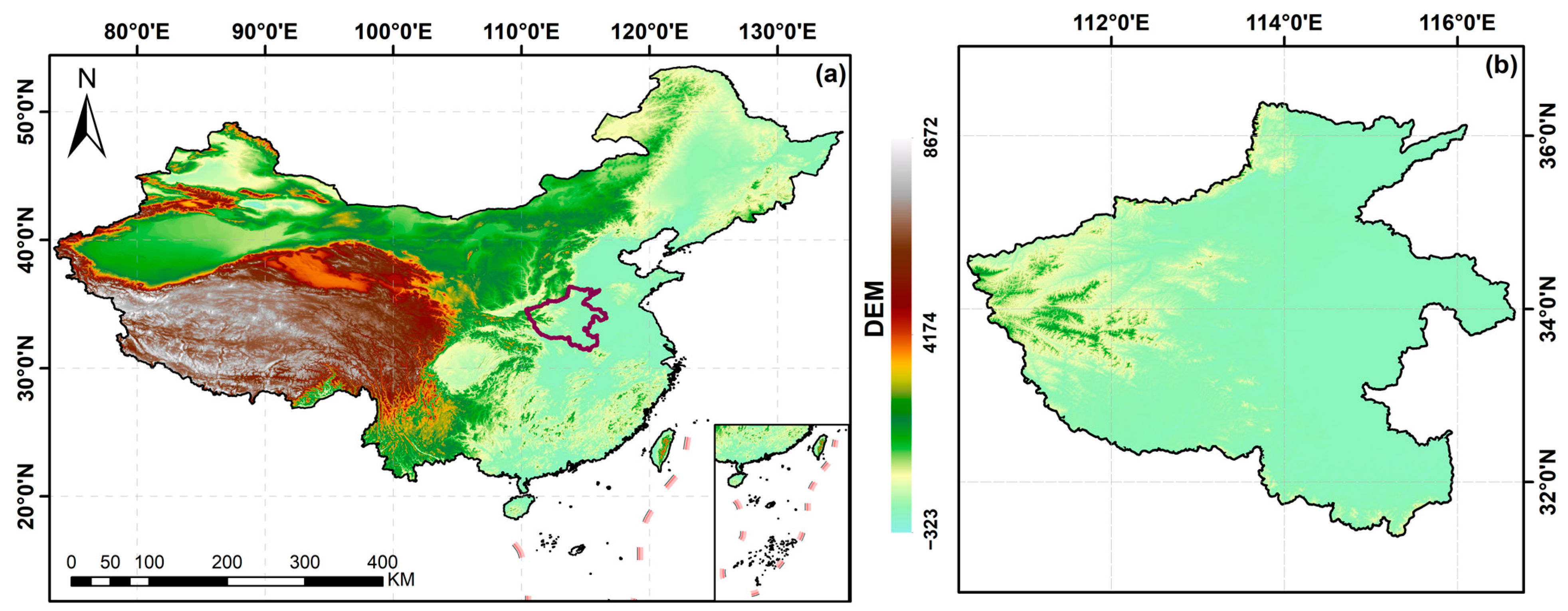
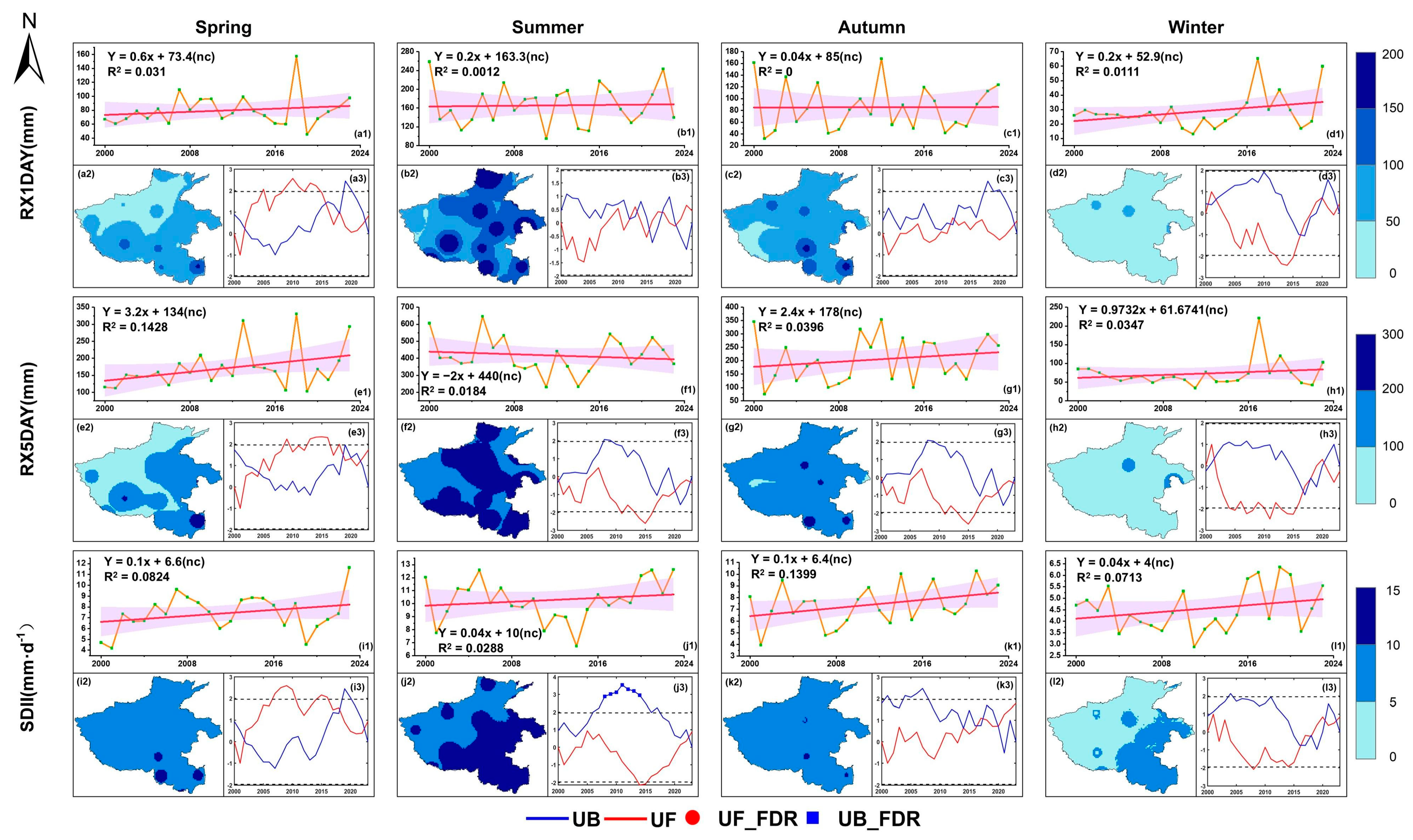

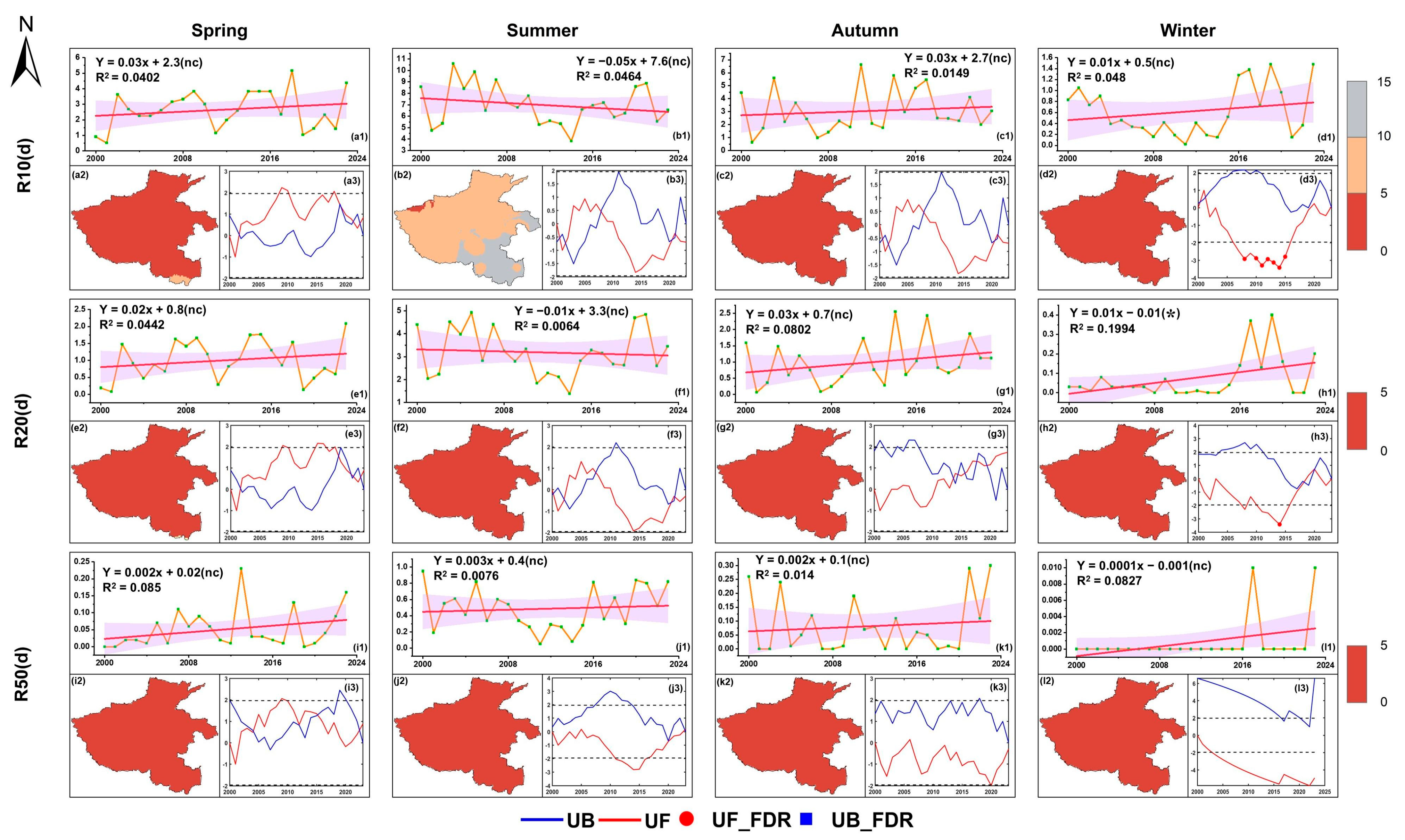
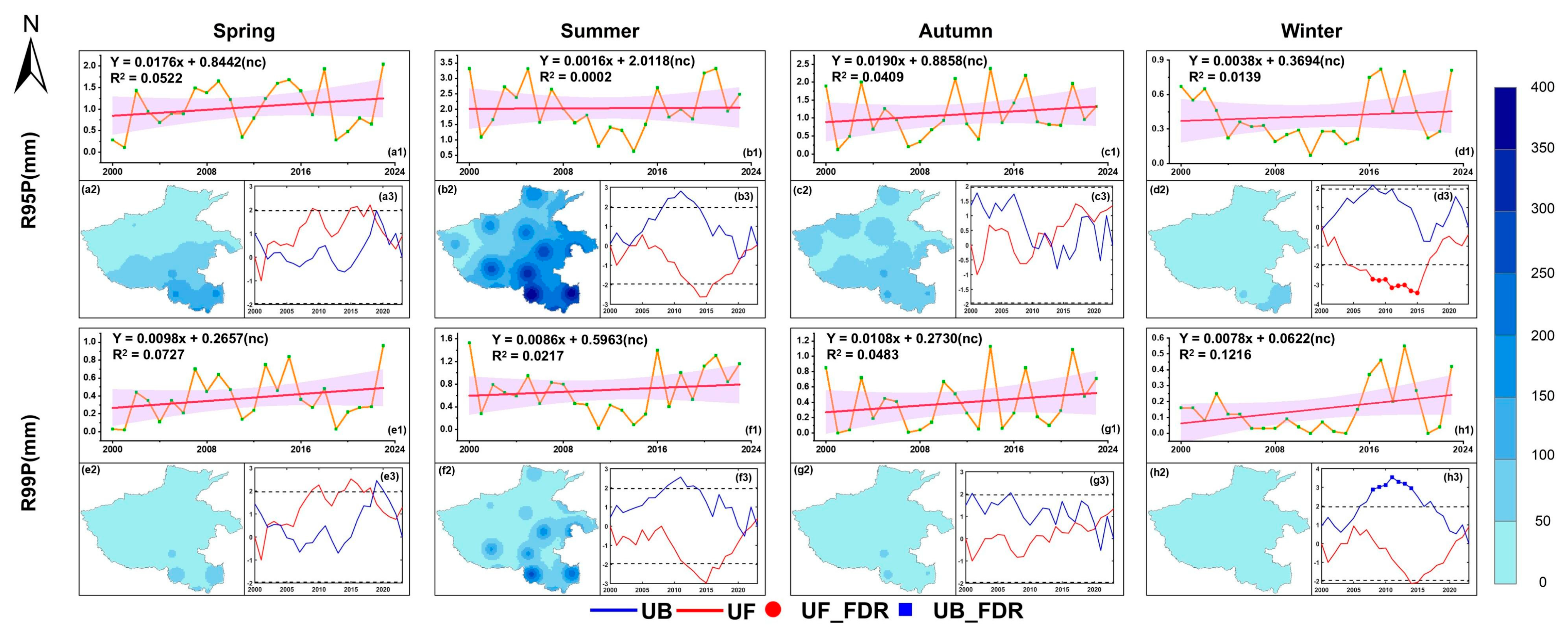
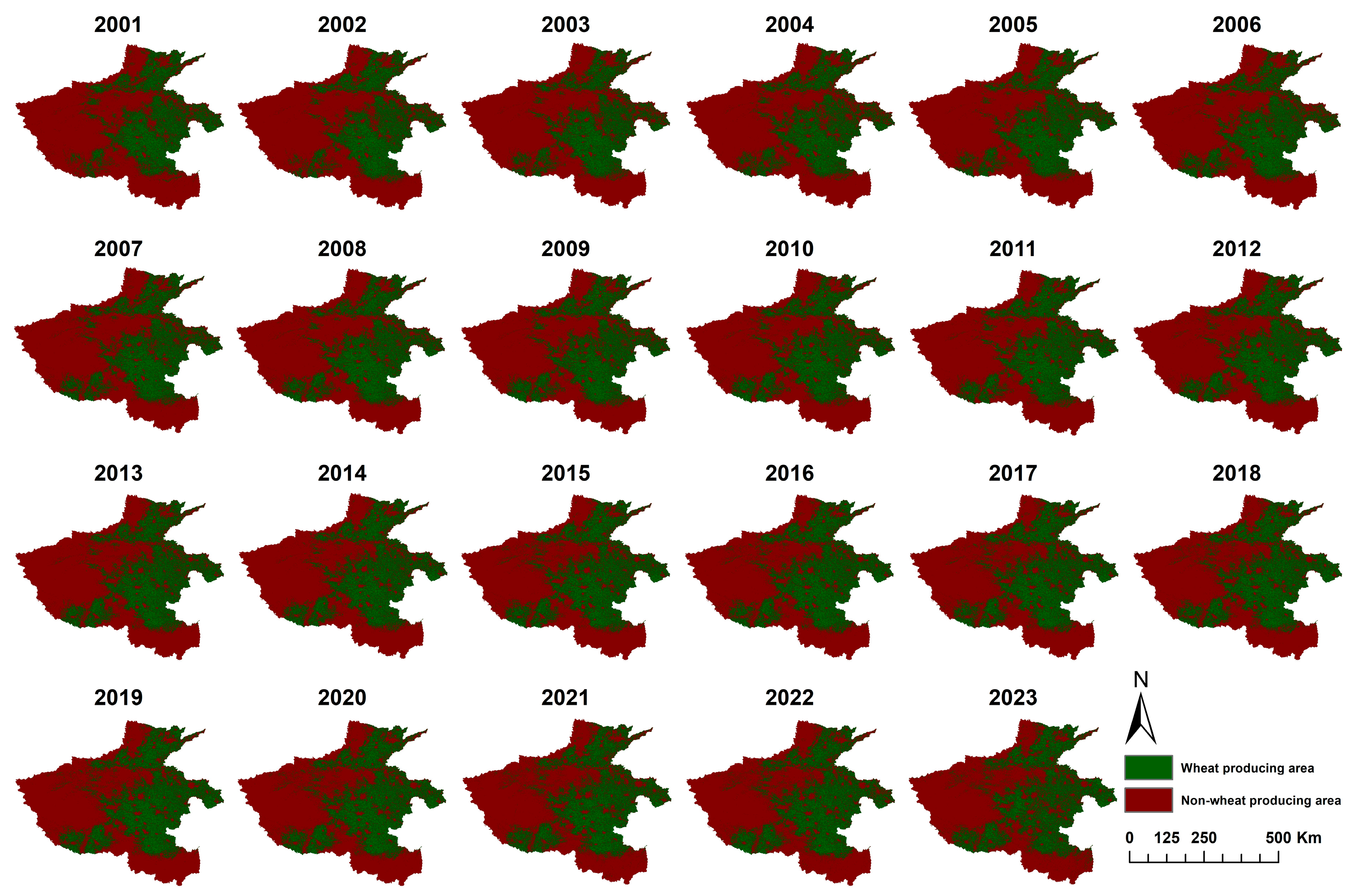
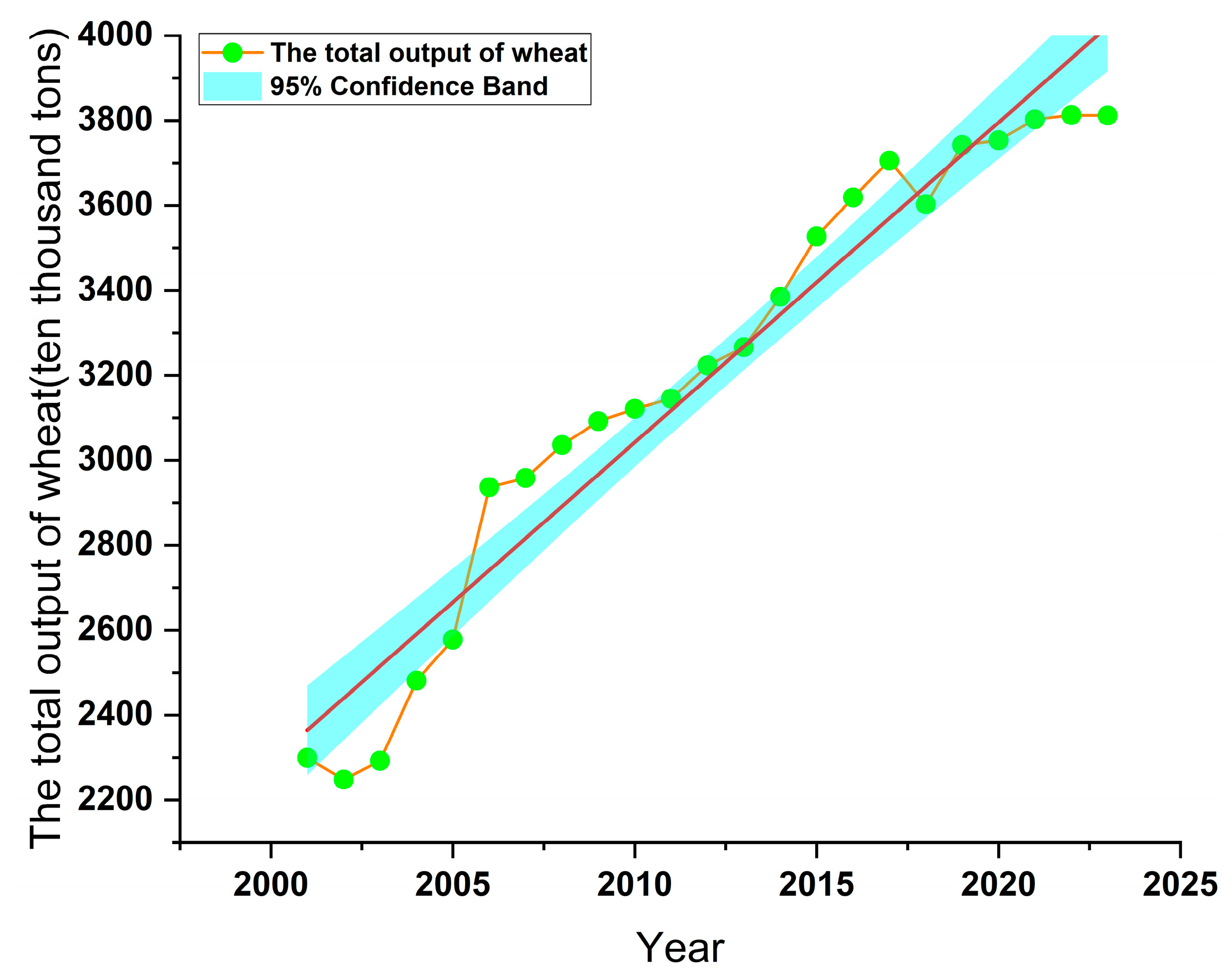
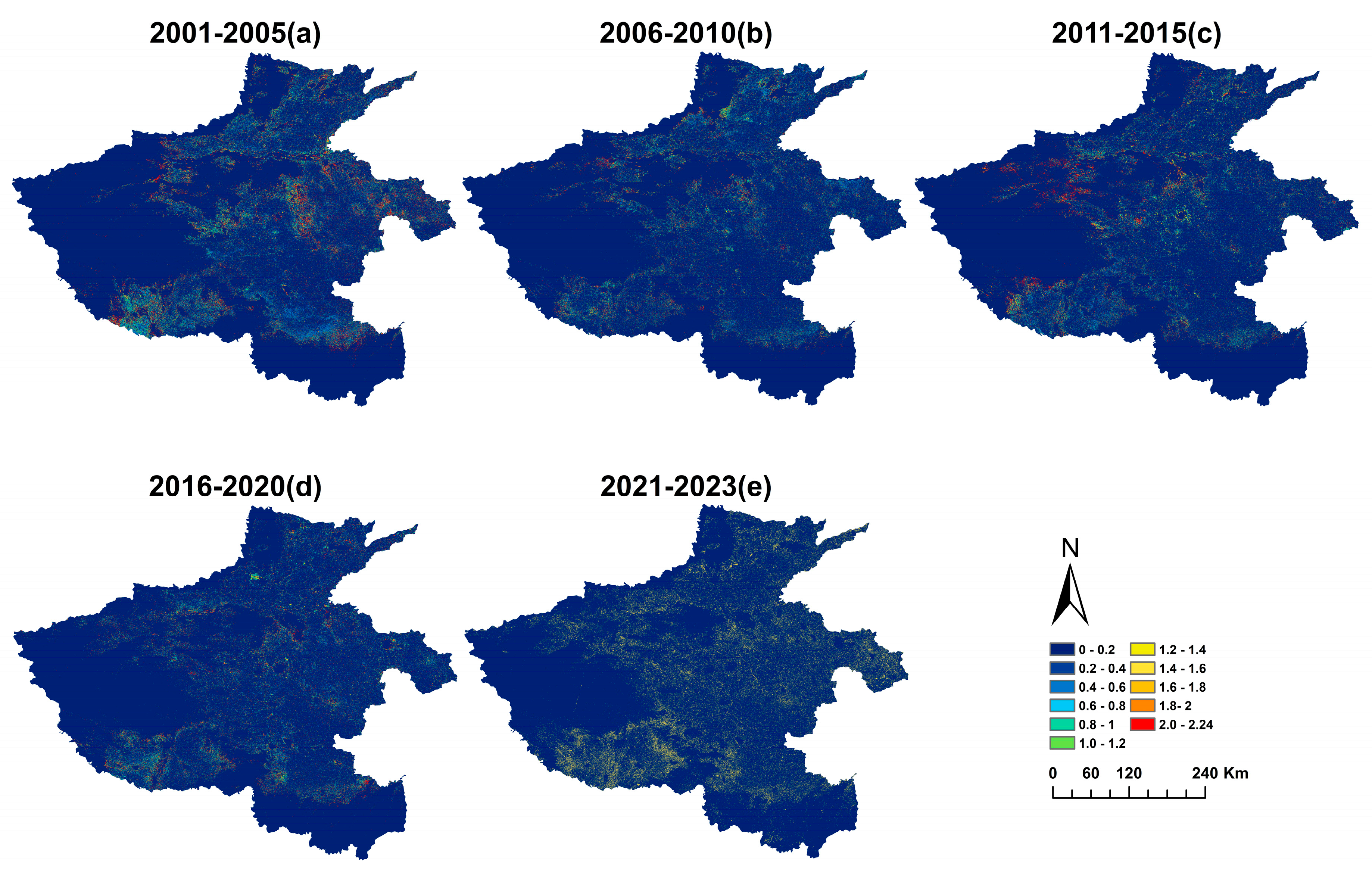
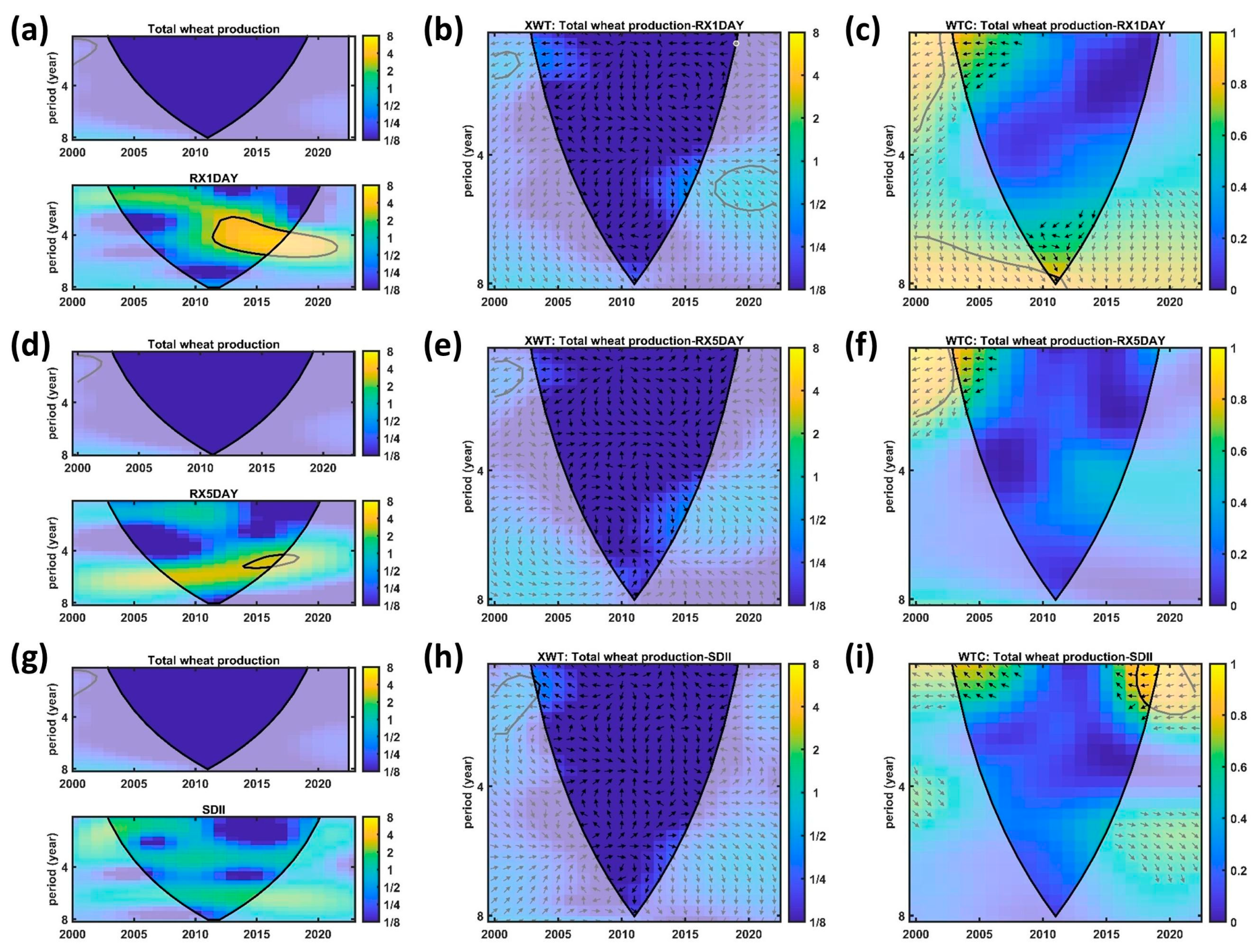
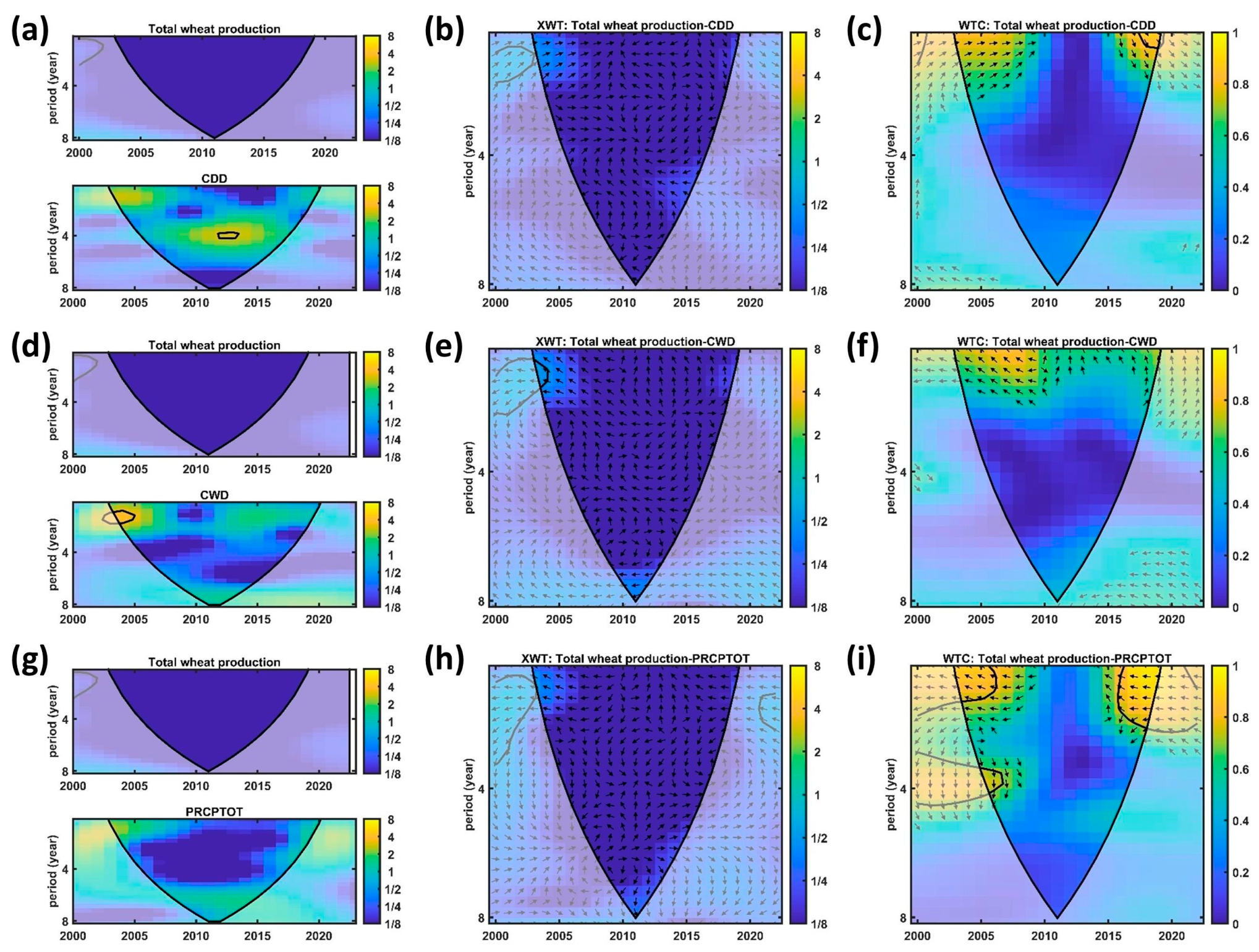
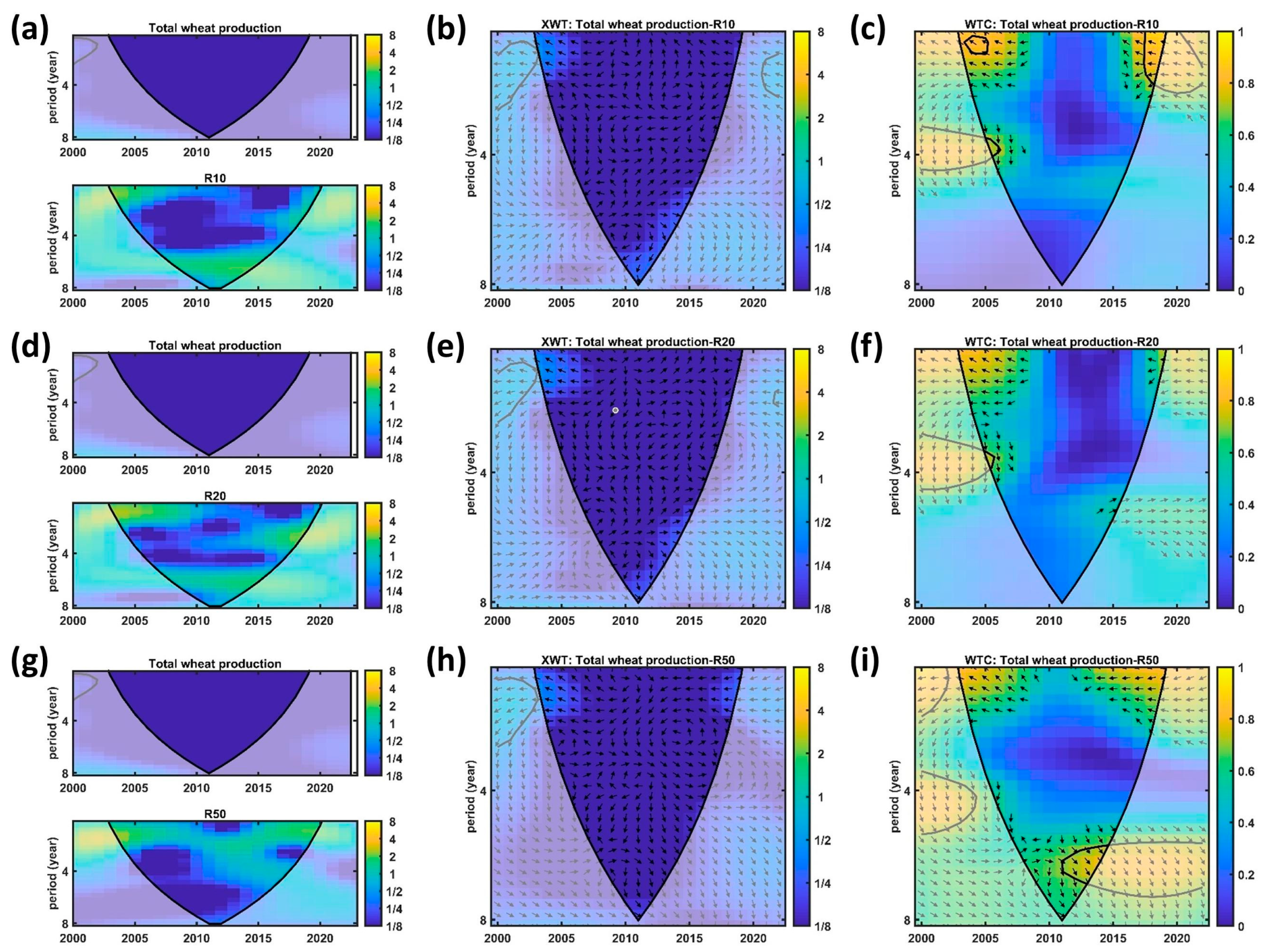
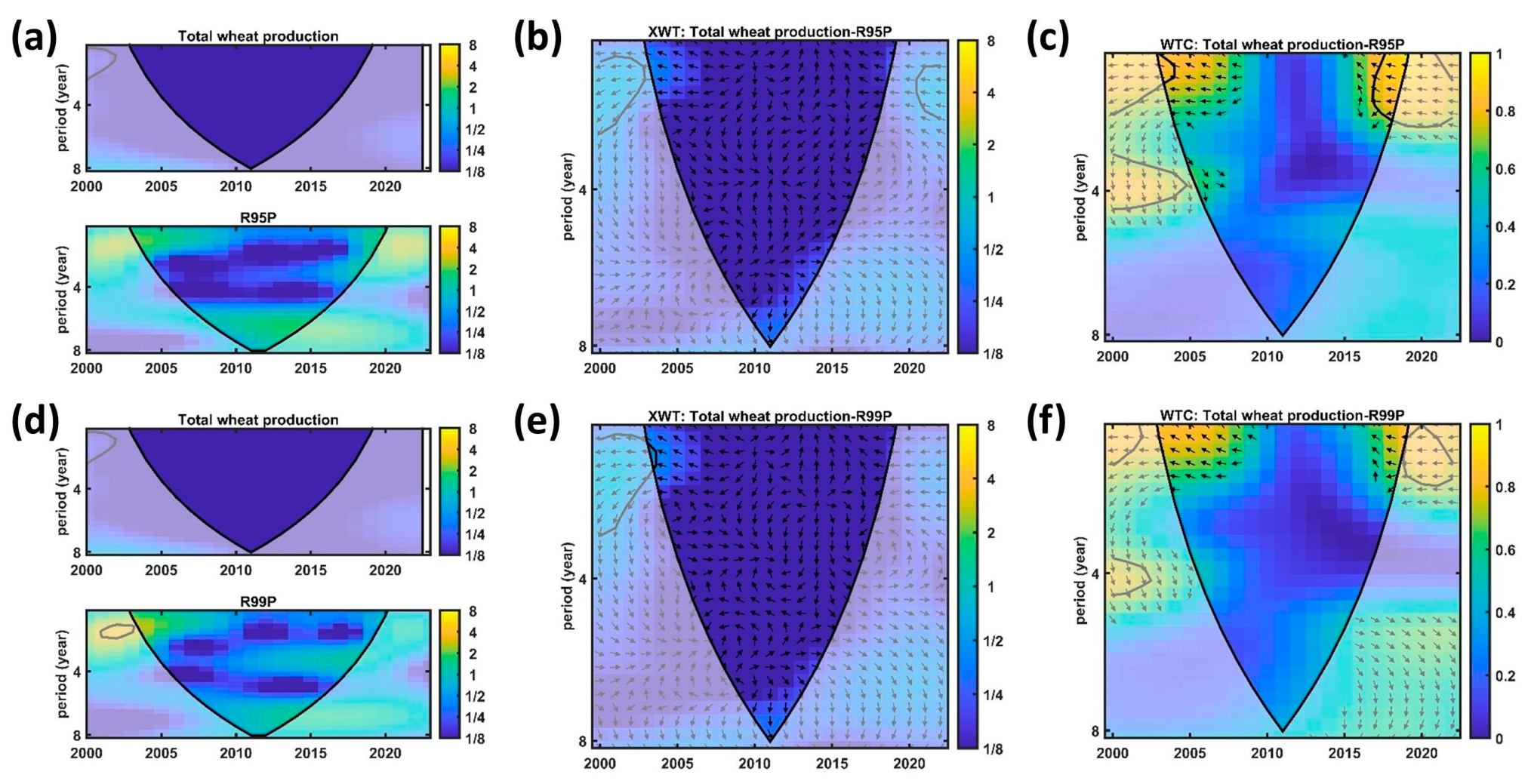
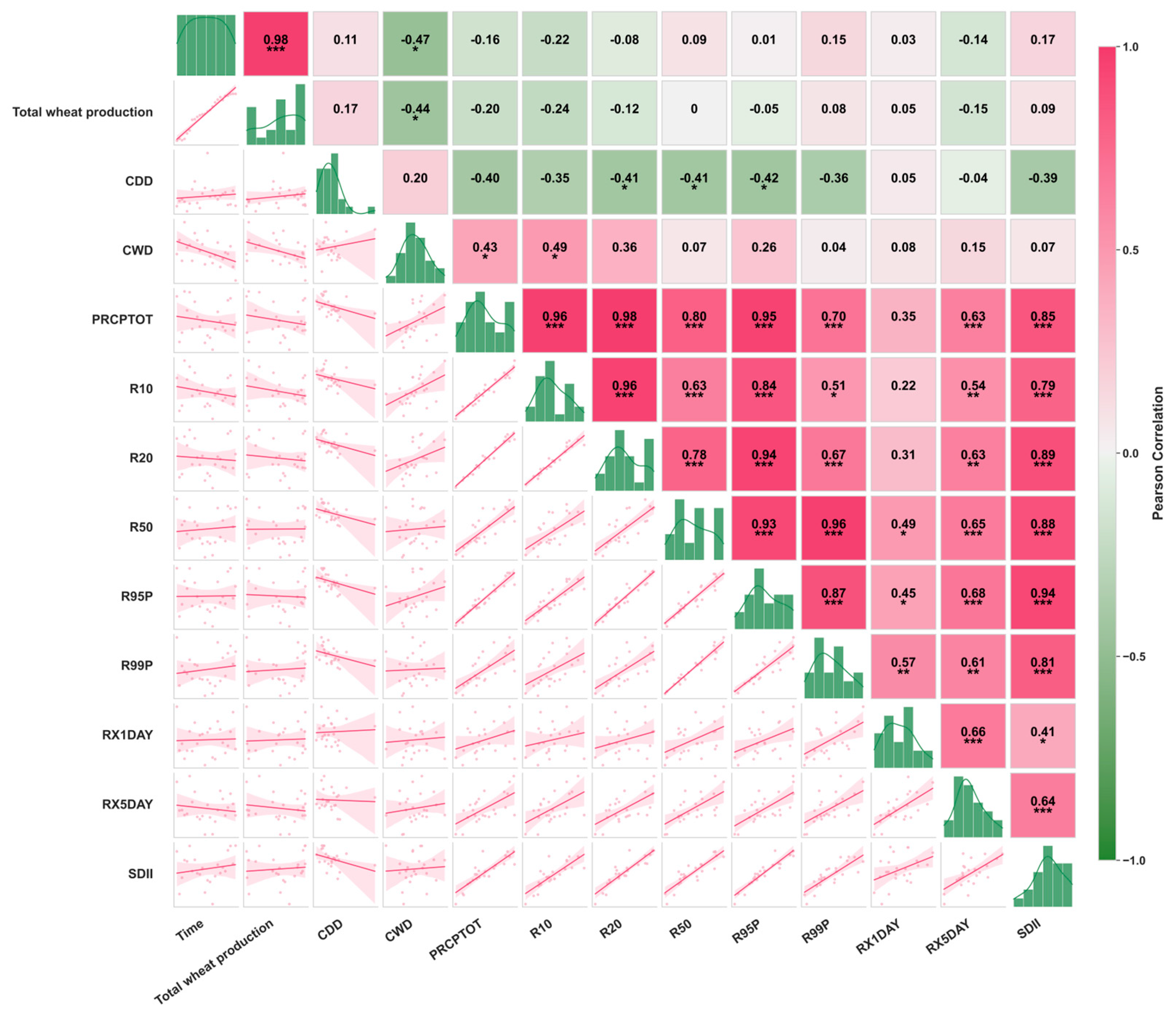
| Category | Code | Name | Definition | Unit |
|---|---|---|---|---|
| Extreme precipitation intensity index | Rx1day | Max 1-day precipitation | Monthly maximum 1-day precipitation | d |
| RX5day | Max 5-day precipitation | Monthly maximum consecutive 5-day precipitation | d | |
| SDII | Seasonal average daily precipitation intensity | Average daily precipitation in each season | mm/d | |
| Extreme precipitation duration index | CDD | Continuous drought days | Longest continuous number of days with precipitation < 1 mm in a quarter | d |
| CWD | Continuous wet days | Longest continuous days of precipitation ≥1 mm in a quarter | d | |
| PRCPTOT | Total seasonal precipitation | Total precipitation in a quarter | mm | |
| Relative threshold index of precipitation | R95p | Extremely strong precipitation exceeding 95% quantile | Seasonal total precipitation when daily precipitation >95th percentile | mm |
| R99p | Extremely strong precipitation exceeding 99% quantile | Seasonal total precipitation when daily precipitation >99th percentile | mm | |
| Absolute threshold index of precipitation | R10 | Moderate rain day | Daily precipitation in the quarter ≥10 mm | mm |
| R20 | Heavy rain days | Daily precipitation in the quarter ≥20 mm | mm | |
| R50 | Rainstorm days | Daily precipitation in the quarter ≥50 mm | mm |
Disclaimer/Publisher’s Note: The statements, opinions and data contained in all publications are solely those of the individual author(s) and contributor(s) and not of MDPI and/or the editor(s). MDPI and/or the editor(s) disclaim responsibility for any injury to people or property resulting from any ideas, methods, instructions or products referred to in the content. |
© 2025 by the authors. Licensee MDPI, Basel, Switzerland. This article is an open access article distributed under the terms and conditions of the Creative Commons Attribution (CC BY) license (https://creativecommons.org/licenses/by/4.0/).
Share and Cite
Sheng, K.; Li, R.; Zhang, F.; Chen, T.; Liu, P.; Hu, Y.; Li, B.; Song, Z. Response of Grain Yield to Extreme Precipitation in Major Grain-Producing Areas of China Against the Background of Climate Change—A Case Study of Henan Province. Water 2025, 17, 2342. https://doi.org/10.3390/w17152342
Sheng K, Li R, Zhang F, Chen T, Liu P, Hu Y, Li B, Song Z. Response of Grain Yield to Extreme Precipitation in Major Grain-Producing Areas of China Against the Background of Climate Change—A Case Study of Henan Province. Water. 2025; 17(15):2342. https://doi.org/10.3390/w17152342
Chicago/Turabian StyleSheng, Keding, Rui Li, Fengqiuli Zhang, Tongde Chen, Peng Liu, Yanan Hu, Bingyin Li, and Zhiyuan Song. 2025. "Response of Grain Yield to Extreme Precipitation in Major Grain-Producing Areas of China Against the Background of Climate Change—A Case Study of Henan Province" Water 17, no. 15: 2342. https://doi.org/10.3390/w17152342
APA StyleSheng, K., Li, R., Zhang, F., Chen, T., Liu, P., Hu, Y., Li, B., & Song, Z. (2025). Response of Grain Yield to Extreme Precipitation in Major Grain-Producing Areas of China Against the Background of Climate Change—A Case Study of Henan Province. Water, 17(15), 2342. https://doi.org/10.3390/w17152342






